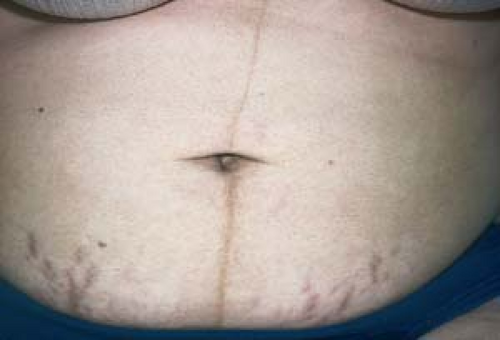Skin and Hair During Pregnancy
Overview
During pregnancy, various skin changes occur. Many of these changes are seen so frequently that they are considered normal. Pregnancy can also alter the course of certain preexisting skin conditions or systemic diseases that have cutaneous involvement, for example:
Systemic lupus erythematosus and scleroderma may flare.
Acne may improve, or it may worsen.
Dyshidrotic eczema may appear de novo, or a flare-up of preexisting lesions may occur.
Condylomata acuminatum may enlarge considerably and may proliferate.
However, it should always be kept in mind that many common skin diseases unrelated to pregnancy should be considered when evaluating a pregnant patient with a skin disorder.
 Hyperpigmentation
Hyperpigmentation
Linea nigra
 Connective tissue changes
Connective tissue changes
Striae gravidarum
Keloids
 Vascular phenomena
Vascular phenomena
Spider telangiectasias
Palmar erythema
 Hair changes
Hair changes
Telogen effluvium
Hirsutism
 Other findings
Other findings
Pregnancy gingivitis
Pyogenic granulomas
Erythema nodosum
 Specific dermatoses of pregnancy
Specific dermatoses of pregnancy
Pruritic urticarial papules and plaques of pregnancy
Pruritus gravidarum
Recurrent cholestasis of pregnancy
Pemphigoid gestationis
 Other conditions
Other conditions
Pruritic folliculitis of pregnancy
Impetigo herpetiformis
Frequently Seen Skin Changes That Are Considered Normal
For patients with melasma caused by pregnancy, it is usually best to keep sun exposure to a minimum and to wait for fading, which often takes place spontaneously. Treatment of persistent nongestational melasma consists of diligent sun avoidance and, frequently, the use of skin bleaching creams (see Chapter 14, “Pigmentary Disorders”).
Darkened freckles, nevi, and linea nigra usually regress postpartum.
Hyperpigmentation
Hyperpigmentation is presumed to be secondary to increased levels of estrogens and melanocyte-stimulating hormone. It frequently manifests as follows:
Darkening of the linea alba (which becomes the linea nigra). There may also be darkening of the nipples and surrounding areolae, as well as darkening of the axillae, thighs, umbilicus, perineum, and external genitalia (Fig. 23.1).
Melasma (for a more complete discussion, see Chapter 14, “Pigmentary Disorders”). The “mask of pregnancy” (formerly known as chloasma) occurs in more than 50% of women. It is worsened by exposure to the sun. Melasma is also seen in women taking oral contraceptives and, on occasion, de novo in women in whom no explanation is obvious.
Darkening of preexisting freckles and nevi.
Pregnancy does not appear to affect survival adversely in women who have preexisting malignant melanoma.
Connective Tissue Changes
Striae gravidarum (striae cutis distensae related to pregnancy) or “stretch marks.” It is thought that these are caused by the combination of increased adrenocortical activity and rapid tissue growth and distension, which result in tearing of the collagen matrix of the dermis and a weakness of elastic fibers. Typically, striae are reddish pink to violaceous, linear, atrophic bands that are located on the abdomen, hips, buttocks, and breasts. The striae are permanent, but the purplish color fades with time.
Proliferation and enlargement of skin tags, with some persisting after pregnancy.
Occasional growth of preexisting keloids. For example, this may occur in the scars of an abdominal hysterectomy or a cesarean section (Fig. 23.2). Growth of preexisting keloids is a not-uncommon problem in women of African descent.
There is no proven effective treatment for striae.
Stay updated, free articles. Join our Telegram channel

Full access? Get Clinical Tree





